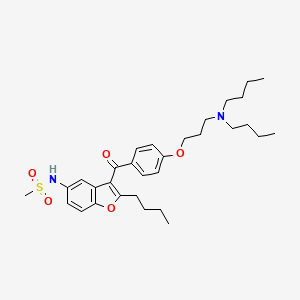D1394 | Dronedarone
C
C01BD07 Dronedarone
[C01BD] Antiarrhythmics, class III
[C01B] ANTIARRHYTHMICS, CLASS I AND III
[C01] CARDIAC THERAPY
[C] Cardiovascular system
| Toxicity | Dose | Time | Species | Model | Method | Action | Positive criterion | Reference |
|---|---|---|---|---|---|---|---|---|
| FATTY ACID METABOLISM | 10µM | 24hr | isolated rat liver mitochondria, and the human hepatoma cell line HepG2 | inhibit | 271 | |||
| Pictogram | Signal | Statements | Precautionary Statement Codes |
|---|---|---|---|
  |
Danger |
Aggregated GHS information provided by 5 companies from 3 notifications to the ECHA C&L Inventory. Each notification may be associated with multiple companies. H360 (40%): May damage fertility or the unborn child [Danger Reproductive toxicity] H373 (40%): Causes damage to organs through prolonged or repeated exposure [Warning Specific target organ toxicity, repeated exposure] H400 (40%): Very toxic to aquatic life [Warning Hazardous to the aquatic environment, acute hazard] H410 (60%): Very toxic to aquatic life with long lasting effects [Warning Hazardous to the aquatic environment, long-term hazard] Information may vary between notifications depending on impurities, additives, and other factors. The percentage value in parenthesis indicates the notified classification ratio from companies that provide hazard codes. Only hazard codes with percentage values above 10% are shown. |
P201, P202, P260, P273, P281, P308+P313, P314, P391, P405, and P501; (The corresponding statement to each P-code can be found at the GHS Classification page.) |

